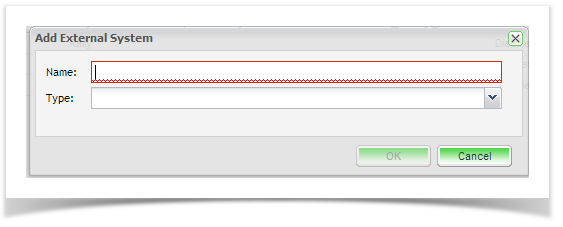To allow integration a few minutes need to be spent configuring your server and project with Rally. Administrator permission to Rally Workspaces is required to configure the Integration.
To add a connection to Rally you first need to add an external system connection:
- Open the ‘Admin’ tab of the tree view.
- Click on Extensions and double click External Systems on the navigator.
.
- From the External System summary screen, you can view all existing connections and view their enabled and configuration status. Click on add from the tool bar and add a Name for your external system connection and select the connection type "Rally".
- The configuration screen of the external system type you chose will appear:
| Field | Description |
|---|---|
| Type | Select the tracker type from the list of supported trackers. |
| Name | Enter a name for the tracker that will identify it within Enterprise Tester. |
| URL | Enter the URL path for the Rally instance. Hosted (full and community editions) **The URL for hosted instances can be left blank. ET will automatically default to this URL when the field is left empty. Trial Instance |
| UserName | Enter a gateway* username for the Rally instance. |
| Password | Enter the password for the gateway username. |
| Enabled? | Check this box to enable the connection to the defect tracker. |
| Ignore Invalid Remote Certificates? | Check this box to ignore invalid remote certificates. |
*We recommend that the Gateway Account has Rally Workspace administration access. This will allow creation, and update of incidents across all projects and will hold sufficient privileges to support enhanced functionality when further integration features are implemented.
When you have completed all the details click on ‘Save’.
Enterprise Tester will automatically test the tracker and will save all details if the connection is validated.
Enterprise Tester will test the external system and will save all details if the connection is validated. The next step is to set up your Enterprise Tester project configuration to your Rally project. Please refer to the topic Synchronizing Requirements with Rally.
ET Requirement Links
A link to the ET requirement can be exposed within Rally by using the Web Link custom field type.
To do this you must followed these steps:
- Add "web link" field to Rally
- Add a new custom field to the workspace (within Rally, go to set-up -> workspaces and projects -> select workspace -> fields, select work item "User Story", then click "New Field".
- From this screen enter the Name and Display Name (we suggest "ETRequirement" and "ET Requirement").
- Set "Type" to "Web Link".
- Configure "URL" template for the Web link field to be "http://${id}" (or if ET is exposed via HTTPS/SSL, use https://${id} instead).
- Leave "Display Preference" as "Display in new window".
- Click "Save & Close" to save the custom field.
- Configure mapping in ET
- Edit external system link for requirements between ET and Rally (if you have not created a link yet between your ET and Rally project, please follow these steps for information on how to do so).
- Click on "Mappings" tab.
- Click on "ET to External System" tab.
- Click on "Map Fields" step, then click "Configure" toolbar button.
- Click "Add" toolbar button to create a new field mapping.
- Select "Copy field" as the type of the new field mapping.
- Select "URL" as the From field.
- Select "Custom Field - ET Requirement" as the To field (if you gave the field a name other than "ET Requirement", you will need to select that field instead.
- Click OK.
- Close the configure mappings field.
At this point any requirement subsequently synchronized to Rally will have the "ET Requirement" field populated with a hyperlink back to the source requirement in Enterprise Tester.



